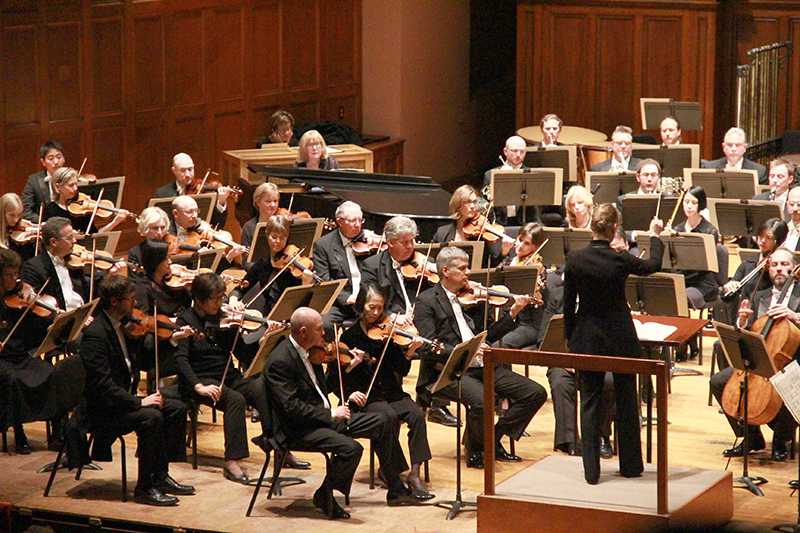Mälkki, Denk Debut with the Cleveland Orchestra in Finney Chapel
Conductor Susanna Mälkki leads the Cleveland Orchestra in a performance at Finney Chapel last Friday. The Orchestra offered renderings of Sibelius’ The Oceanides, a suite from Stravinsky’s Pétrouchka and Bartok’s Piano Concerto No. 3.
May 1, 2015
Embracing her Finnish roots, Susanna Mälkki opened last Friday’s installment of the Artist Recital Series by conducting the Cleveland Orchestra in legendary Finnish composer Jean Sibelius’ The Oceanides. The tone poem musically represents the feminine spirits who animate the ocean in Greek mythology. The gentle undulation of the string figures proved a tender welcome to Finney Chapel, where the orchestra has performed annually since 1919.
A low rumble in the timpani heralded a lilting ostinato in the strings that mirrored the motion of waves. Atop this delicate texture, two flautists played the dancing melody of the sea nymphs with effortless grace. Although Friday marked Mälkki’s debut with the Cleveland Orchestra, she led the musicians with confident ease, expertly manipulating the balance to draw out the different colors of Sibelius’s poem. Each instrumental voice was clearly audible: The brass was never too loud and the winds and strings were never too soft.
The performers emphasized the modal tonality of The Oceanides, evoking both ancient times and the low temperatures of the composer’s frosted homeland. At the dramatic peak of the work, Mälkki gestured sweepingly to stress Sibelius’ chromatic suspensions before allowing the music to relax back into a stable harmony, creating a musical sense of ebb and flow that effectively complemented the poem’s subject.
Unlike the powerful yet slow swells of the tempestuous Oceanides, the opening to Igor Stravinsky’s suite from the ballet Pétrouchka began with explosive passion. Gone was the gentle impressionism. Gone were the gossamer textures. Instead, the orchestra played with an aggressive fire, nimbly alternating between Stravinsky’s complex polyrhythms and the simple Russian dance tunes.
Detailed program notes allowed listeners to follow along with the in-depth narrative of the music, to hear the moment when the puppet Pétrouchka leaps to life, the moment when a rival marionette ruthlessly slays Pétrouchka with a scimitar and the moment when the puppet’s ghost thumbs its nose at its frightened former puppet-master. The orchestra performed each of these cues with a convincingly dramatic flair, with the bassoonists and English horn player in particular committing to the humorous quirk of their musical characters.
Especially impressive was the famous trumpet solo in the third movement, spectacularly performed by principal trumpet player Michael Sachs. He delivered the march-like tune with a velvet smoothness, never faltering. Though later in the piece there were occasional instances in which the strings and brass lost rhythmic integrity, the sheer energy with which the orchestra played rendered Pétrouchka an exciting conclusion to the concert.
Sandwiched between the two orchestral masterworks, pianist Jeremy Denk, ’OC 90, made his debut with the orchestra along with Mälkki, performing Béla Bartok’s Piano Concerto No. 3. Like much of Bartok’s music, the concerto features a wealth of material drawn from popular Hungarian tunes. Bartok weaves the tunes into a light, neoclassical texture, creating a richly colored, highly structured piece.
The orchestra played with sensitivity, never overpowering Denk yet capturing the more fervent moments of the music with appropriate ardor. Denk, however, disappointed. His technical mastery was certainly evident, as was his obvious dedication to his stylistic choices, but his overemphasis of the concerto’s humor distracted from the music’s simple beauty. Instead of light comedy, Denk presented an aural and visual caricature of the concerto from the insistent bobbing of his head to the indifferent shrug with which he ended the first movement.
In the second movement, Denk expressed Bartok’s hushed chorales with a beautiful understatement, but as soon as the music accelerated into the third movement, the gravitas vanished from his playing. A heavy, recurring timpani solo provided a welcome contrast to Denk’s overstated whimsy, grounding the movement with authority. But throughout the movement, the pianist’s casual handling of even the most demanding technical passages strayed dangerously close to flippancy. Though clearly a brilliant musician, Denk’s artistic choices diverted attention from the mature aesthetic of Bartok’s concerto, temporarily blemishing an otherwise enchanting visit from the Cleveland Orchestra.





















